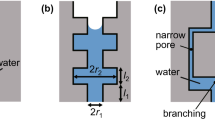Abstract
The prevailing current wisdom about how to properly formulate an algorithm to describe spontaneous and coupled spontaneous/induced capillary imbibition into and through the interstices of porous Darcian scale sediments implies, but perhaps incorrectly, that the early empirical relations of Buckley and Leverett (1942) can safely be employed. Here this persistently popular point of view is found to be inadequate since it overlooks taking into full account how common sense suggests that it is surface energy gradient driving forces which are the underlying cause for the occurrences of these processes. Specifically it will be noted that a satisfactory algorithm to model cases where spontaneous capillary imbibition occurs will not be one which ignores the fact that necessarily the local free surface energy is continuously diminished in magnitude until a minimum value together with a maximum entropy condition has been reached. Hence, the conclusion is drawn herein that the Buckley–Leverett formulations alone at best can only be used to describe what is called those induced capillary imbibition processes caused by the action of mechanical energy driving forces.
Similar content being viewed by others
References
Adam, N. K.: 1930, The Physics and Chemistry of Surfaces, Clarendon Press.
Allen, Myron: 1988, Multiphase Flow in Porous Media: Mechanics, Mathematics, Numerics, Springer-Verlag, New York.
Ayub, M. and Bentsen, R. G.: 1999, Interfacial coupling, J Petrol Sci Engng 23, 13-24.
Bartley, J. T. and Ruth, D. W.: 1999, Relative permeability of tube bundle models, Transport in Porous Media 35, 161-187. cF also Rose, W.: 2000, commentary, Transport in Porous Media 40/3, 356-358.
Bear, Jacob: 1972, Dynamics of Fluids in Porous Media, Elsevier, New York.
Bentsen, R. G.: 1999, A manuscript under peer review titled: The physical origin of interfacial coupling in 2-phase flow in porous media, Private Communication.
Buckley, S. E. and Leverett, M. C.: 1942, Mechanism of fluid displacement in sands, Trans. AIME 146, 107-116.
Champion, F. C. and Davy, H.: 1936, Properties of Matter, Blackie & Son, London, pp. 98-164.
Collins, R. E.: 1961, Flow of Fluids Through Porous Media, Reinhold, New York.
Dullien, F. A. L.: 1992, Porous Media: Fluid Transport and Pore Structure, 2nd edn, Academic Press, New York.
Hadad, A., Bensbat, J. and Rubin, H.: 1996, Simulation of multiphase flow in porous media focusing on the capillary fringe of oil-contaminated aquifers, Transport in Porous Media 12, 245-269.
Kaviany, M.: 1995, Principles of Heat Transfer in Porous Media, Springer Verlag, Berlin.
Luikov, A. V.: 1966, Heat and Mass Transfer in Capillary Bodies, Chap 5, 6, Pergamon Press, Oxford.
Marle, Charles: 1981, Multiphase Flow in Porous Media, 3rd edn, Editions Technip, Paris; Gulf Publishing Co, Houston.
Morel-Setoux, H. S.: 1969, in: Roger De Wiest (ed.), Flow Through Porous Media, Chap 11, §2.4, §2.5, Academic Press, NY.
Richards, L. A.: 1931, Capillary conduction of liquids through porous medium, Physics 1, 318-333.
Rose, W.: 1963, Aspects des processus de mouillage dans les solides poreux, Revue de l'Institut Franc¸ais du Pétrole (IFP) 18, 1571-1590.
Rose, W.: 1988, Attaching new meanings to the equations of Buckley and Leverett, J. Petrol. Sci. Engng 1, 223-228.
Rose, W.: 1999a, Myths about later-day extensions of Darcy's Law, in: Proceedings of the Second International Non-Renewable Energy Sources Congress, Fundamentals (Porous Media Coupled Transport Processes), to appear in Journal of Petroleum Science & Engineering, special issue (2000a), cf. http://www.uiuc.edu/~wdrose/DARCY.html, pp. 724-744.
Rose, Walter: 1999b, 'Relative Permeability Ideas-Then and Now'. Proceedings of the SPE Eastern Division Regional Meeting, Paper # 42718, SPERE rev., 2000b.
Scholz, Hubertus: 1981, Transportprozesse in porosen median: Literturbericht, Akademie der Wissenschaften der DDR, Institut fur Mechanik, 178.
Scheidegger, A. E.: 1974, The Physics of Flow through Porous Media, 3rd edn, University of Toronto Press.
Siddiqui, Fareed and Lake, Larry: 1992, A dynamic theory of hydrocarbon migration, Math. Geol. 24, 305-328.
Tribus, Myron: 1961, Thermostatics and Thermodynamics, D. Van Nostrand, Princeton.
Wooding, R. A. and Morel-Seytoux, H. S.: 1976, Multiphase flow through porous media, Annual Review fo Fluid Mechanics 8, 233-274.
Author information
Authors and Affiliations
Rights and permissions
About this article
Cite this article
Rose, W. A Technical Note: Theory of Spontaneous Versus Induced Capillary Imbibition. Transport in Porous Media 44, 591–598 (2001). https://doi.org/10.1023/A:1010624030630
Issue Date:
DOI: https://doi.org/10.1023/A:1010624030630




